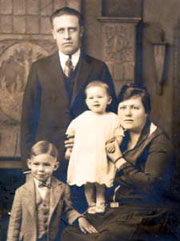
No. 11, Spring 2000
Standing Up to the Ku Klux Klan: Mennonite Missionaries in North Carolina

Photograph courtesy of Ruth Siemens Dunn
It was a Sunday evening in September 1925. Peter and Katherine Siemens (pictured at right with their children Paul and Ruth in about 1931) had just been ordained by the Elk Park Krimmer Mennonite Brethren (KMB) Church, a black congregation in western North Carolina. Shortly after the service, word came that a party of men was at the gate and wished to speak to the ministers. The women were apprehensive and did not want the ministers to go out into the night. So they sent word that the visitors could come inside if they had important business to discuss.
To the astonishment of all, several Ku Klux Klan members, dressed in long white robes and hoods, filed into the church. Only their eyes and the pistols that hung by their sides were visible. All of the congregational members were very frightened. Peter Siemens asked them what they wanted, but before they could respond fellow KMB minister Joseph Tschetter said, “we will have a word of prayer.” After prayer, the visitors asked the ministers to dismiss the congregation and send the members home. The church members returned with guns, knives and sticks, however, and waited outside, ready to defend the ministers if the need arose. The Klan members stated that colored people did not need white men to work with them. They also claimed that the missionaries preached the wrong doctrine and told them, “you do not believe the Bible the way we do.” Siemens and Tschetter invited them to come and attend services at any time, but the men responded that, “there is not enough room.” The ministers then invited a few to come at a time to see if they really did preach wrong doctrine.
After the encounter the two couples went home for the night, comforting themselves with the words of Psalm 4:8, “I will lay me down in peace and sleep for the Lord only maketh me dwell in safety.” In the morning there was a note under the front door, which said that the two couples were to leave immediately. Joseph and Katherine Tschetter were already preparing to return to Chicago, their home community. Peter and Katherine Siemens, however, had no plans to return to their home church, the Zion KMB Church in Dinuba, California. They had just arrived to take over the mission. The following day a man came to the house and asked what they would do if the Klan forcibly evicted them. Peter replied, “If they send us on the train we’ll be back on the next train, but if you send us in coffins we cannot come back.”
This encounter was not the first between the KMB missionaries and local members of the Klan. In 1900 Henry and Elizabeth Wiebe, of Lehigh, Kansas, were the first KMB missionaries to go to North Carolina. They went to teach in two schools opened by Emily Prudden – one for black children and one for white children. She had sent out a call for Christian teachers to come and teach in the schools. Peter V. Wiebe, a KMB missionary, was working at the time in Kentucky. He relayed the message just when the KMB conference was seeking to open a mission in North Carolina. The morning after Henry Wiebe taught his first day in the Prudden school he found a note scribbled on his porch: “We the citizens of Elk Park will not allow a white man to stoop so low as to teach coloreds. They have enough of their own to teach them. Your time is up this day.” Undaunted, Wiebe persisted. He endured a great deal of harassment and name calling, but was never physically harmed.
Jacob and Katherine Tschetter arrived in Elk Park in 1903. Soon thereafter, Jacob was walking along the railroad trestle when two men confronted him. They told him that they did not want any white folks working with the local black population. “We have come here to kill you,” they said. So Jacob knelt down and prayed for the two men, asking God’s forgiveness for the act they were about to commit. After a lengthy prayer, he opened his eyes and saw that the men were gone. He picked up his hat and went home rejoicing that his life had been spared.
Some Klan members later became staunch friends of these KMB missionaries. Some of them eventually did visit the Elk Park congregation, as they had been invited to do on that evening in 1925. Henry and Elizabeth Wiebe served in North Carolina from 1900 to 1908, Joseph and Katherine Tschetter from 1903 to 1925, Peter and Katherine Siemens from 1925 to 1956. Today six congregations constitute the North Carolina District Conference of Mennonite Brethren Churches.
Years later, Katherine Siemens reflected on their difficult experiences with the words of Psalm 37:5: “Commit thy way unto the Lord, trust also in Him, and He shall bring it to pass.”
